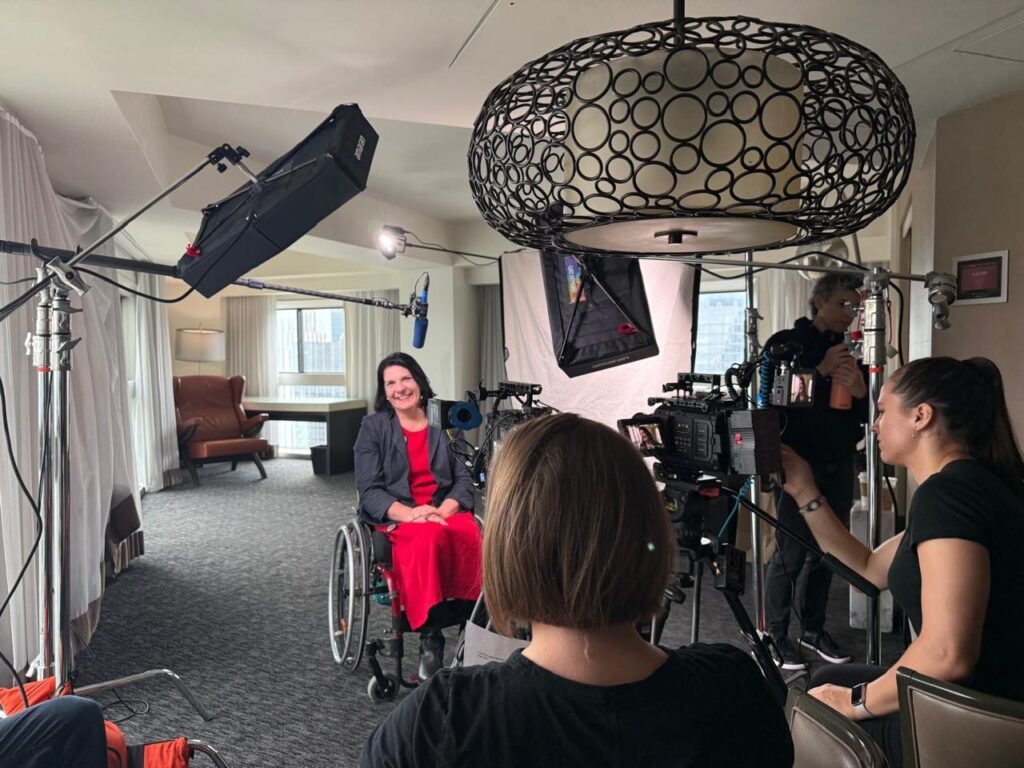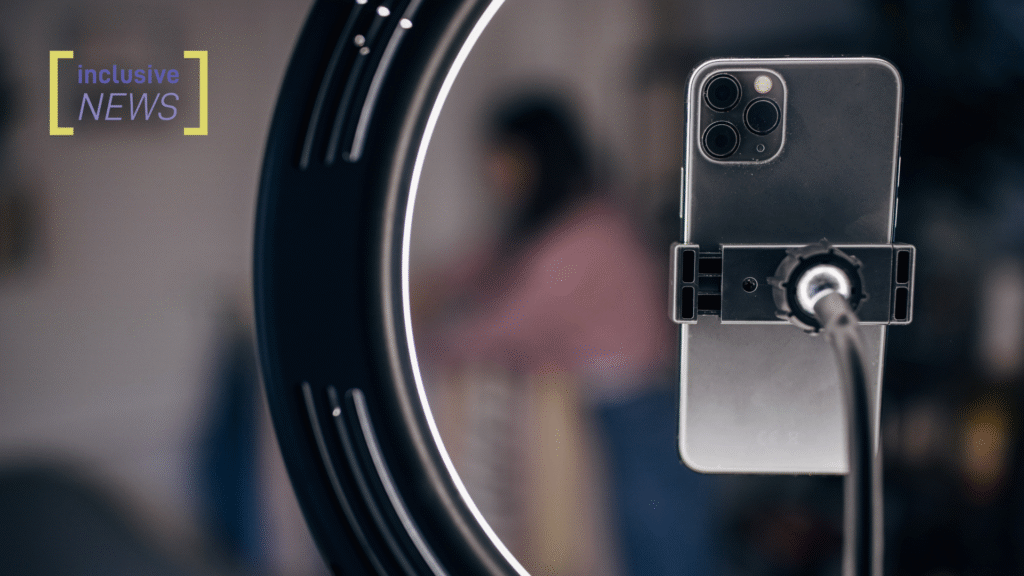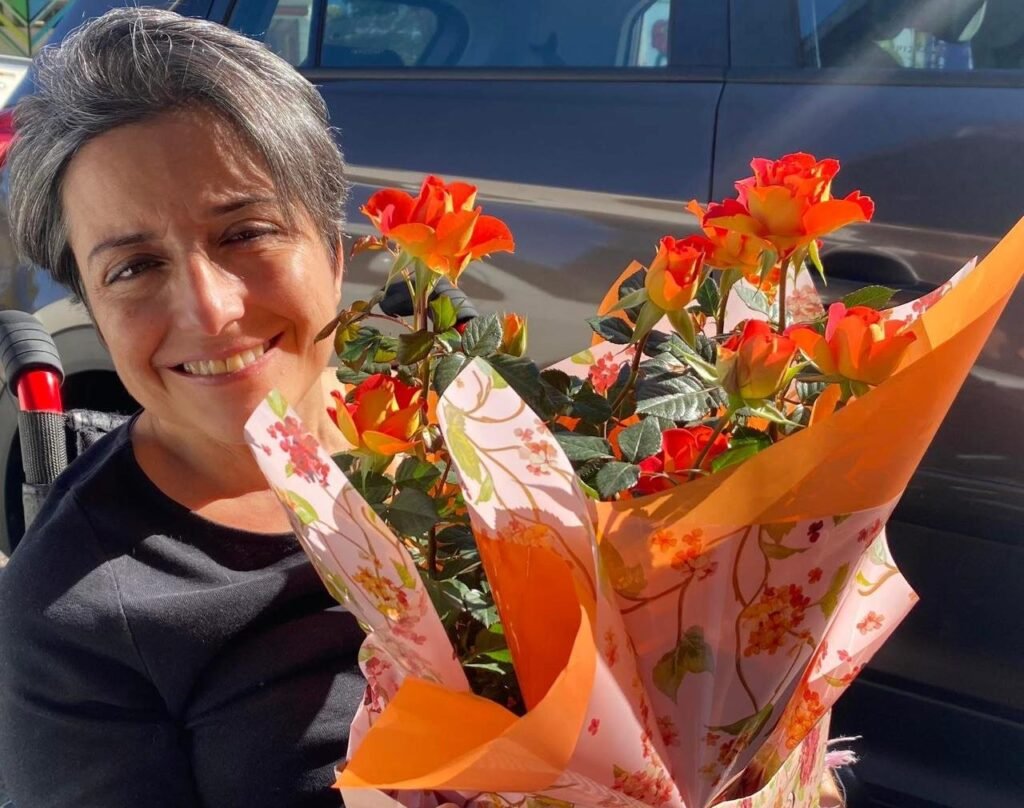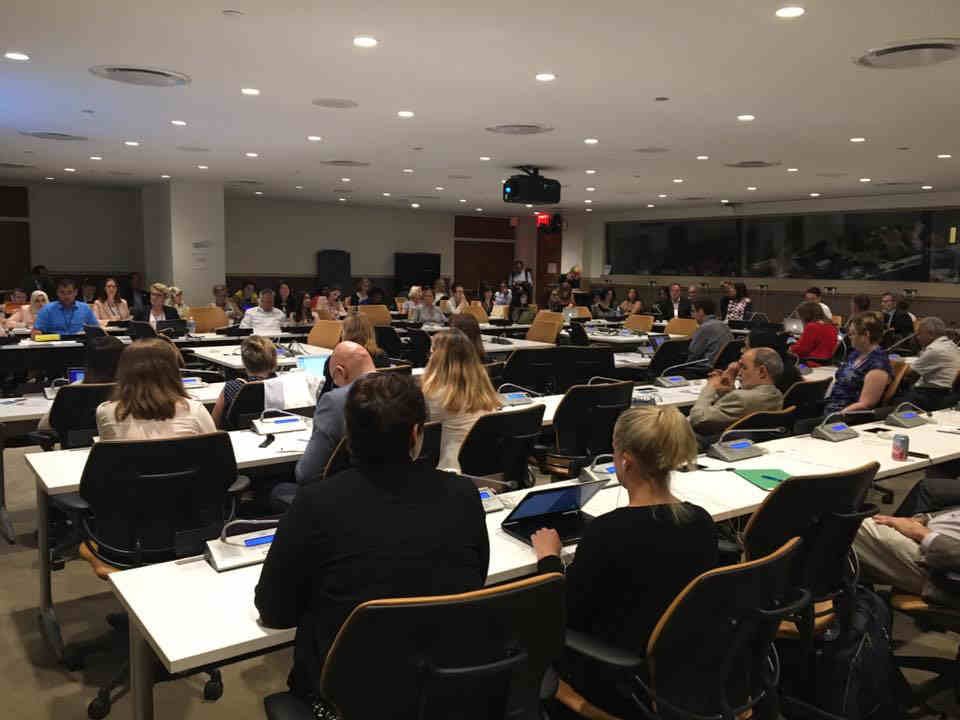
Sala do evento sobre inclusão das pessoas com deficiência na mídia.
ENGLISH TRANSLATION AT THE END
As Missões do Brasil e da Itália junto às Nações Unidas promoveram um evento sobre a importância da inserção das pessoas com deficiência na mídia como forma de promover a inclusão durante a X Conferência dos Estados Parte da Convenção sobre os Direitos das pessoas com Deficiência (CDPD), na sede da ONU em Nova York. O evento foi organizado pelo Alto Comissariado das Nações Unidas para os Direitos Humanos, pela Relatora Especial da ONU para os Direitos das Pessoas com Deficiência e pela GADIM – Aliança Global para Inclusão da Deficiência na Mídia e Entretenimento.
Com base no artigo 8 da CDPD sobre conscientização e no artigo 5º sobre igualdade e não discriminação, o evento paralelo buscou discutir estratégias que possam ser lideradas a nível local, nacional, regional e internacional para combater a invisibilidade, promover percepções positivas e combater o estigma e estereótipos contra pessoas com deficiência. Pesquisas mostram que as pessoas com deficiência estão presentes em menos de 1% das produções de entretenimento, com 95% dos personagens com deficiência desempenhados por atores sem deficiência (dados da TV americana).
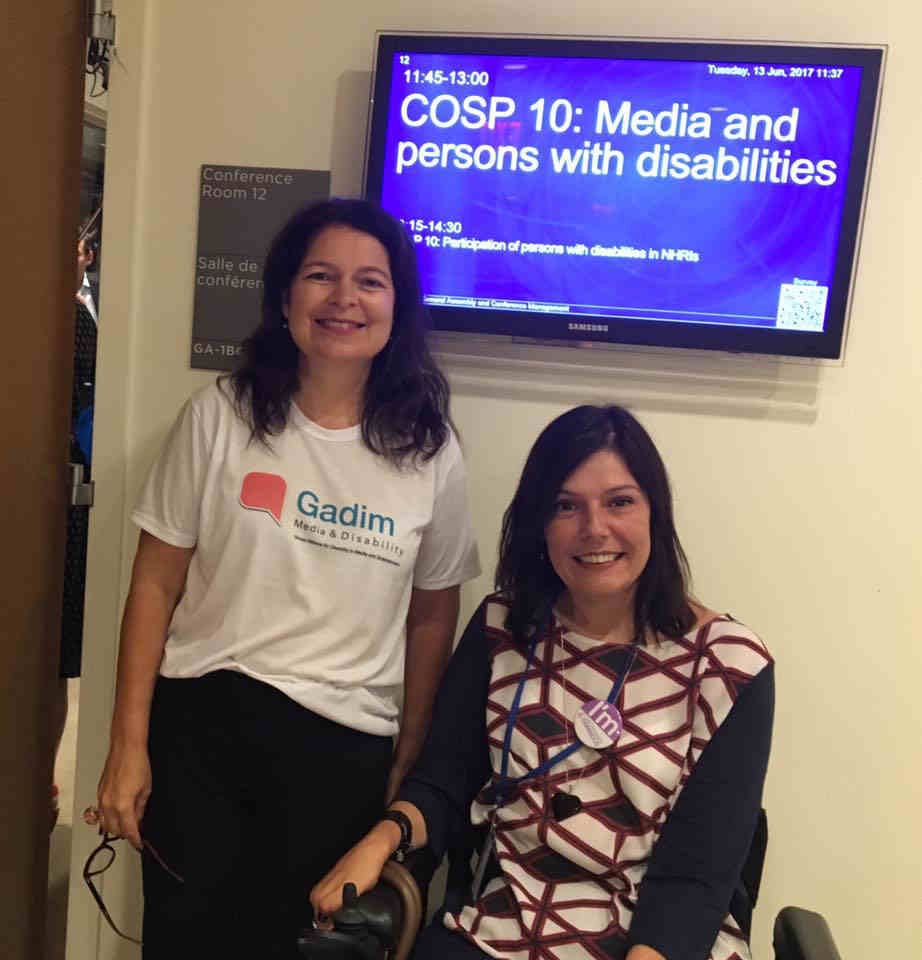
Patricia Almeida, da GADIM e Flavia Cintra, da TV Globo.
No evento “Como promover a inclusão através da mídia”, a repórter do Fantástico, Flavia Cintra, falou sobre sua atuação nos bastidores, subsidiando a produção da novela “Viver a Vida”, de Manoel Carlos, exibida pela TV Globo em 2009. Ela descreveu a reação do público em relação à personagem Luciana, vivida por Alinne Moraes, uma modelo que se torna tetraplégica no começo da trama. Segundo Flavia, no início, todos perguntavam quando a modelo iria se curar. Mais tarde, ao agir como uma menina mimada, as pessoas ficavam com raiva da personagem. Da mesma maneira, se indignavam quando a modelo enfrentava barreiras como a falta de acessibilidade. Ao verem Luciana se apaixonar, o público torceu pelo romance e ficou curioso para saber se uma tetraplégica seria capaz de ter vida sexual. No final, depois de vários meses de “convivência” diária através da novela, o telespectadores só queriam que Luciana fosse feliz. E o final feliz não passou pela cura, mas pelo casamento e nascimento dos filhos gêmeos. A jornalista, também mãe de gêmeos, afirmou que a novela permitiu ao público “aproximar-se” da personagem e conhecer de perto sua vida. E que essa convivência contribuiu, muitas vezes, para rever ideias pre-concebidas, naturalizar o olhar e mudar atitudes com relação às pessoas com deficiência em geral. Posteriormente, Flavia foi contratada como repórter pelo Fantástico, o maior programa jornalístico da TV e disse que viveu processo parecido. No começo, era vista como a repórter cadeirante, e agora se tornou só a Flávia do Fantástico.
O Gerente de Responsabilidade Social da TV Globo, Raphael Vandystadt, falou sobre a atuação da emissora na mobilização em torno de temas sociais e apresentou números. Citou o programa Criança Esperança, realizado com a UNESCO, que viabiliza inúmeros projetos, inclusive na área da deficiência. Disse que no último ano foi lançada a iniciativa de promoção dos direitos humanos “Tudo começa pelo respeito” com apoio do UNICEF, UNAIDS e ONU Mulheres. O programa compreende ações do jornalismo, programas de TV, novelas e de formação de funcionários. Organizações de pessoas com deficiência como o Instituto Meta Social, o Movimento Down e o Instituto Rodrigo Mendes colaboraram em vários dos projetos. Na última semana do Dia Internacional da Síndrome de Down foram realizadas mais de 100 reportagens e lançado vídeo que alcançou 2 milhões de pessoas e recebeu 16 mil compartilhamentos nas redes sociais. De acordo com o representante da TV Globo, personagens com deficiência fazem parte da TV Globo desde 1975, e, de 2007 até hoje foram contabilizadas mais de 413 cenas envolvendo esses personagens. Segundo ele, as novelas promovem o debate e a reflexão, provocando novos comportamentos a respeito de vários assuntos. Do mesmo modo, só em 2016, a TV Globo mostrou mais de 300 reportagens mencionando pessoas com deficiência. Além disso, desde 2007, em parceria com 17 entidades, a emissora produziu e exibiu sem custo, 28 campanhas cujos temas foram pessoas com deficiência. Essas campanhas totalizaram 279 mil inserções, um investimento equivalente a US$ 48 milhões. Raphael encerrou a apresentação com o vídeo da série Tudo começa pelo Respeito, feito em parceria com o Instituto Rodrigo Mendes.
Luca Pannese, da agência Publicis e Raphael Vandystadt, da TV Globo.
O publicitário italiano Luca Pannese, da agência Publicis, com base em Nova York, falou a respeito das campanhas para o Dia Internacional da Síndrome de Down, desenvolvidas junto com seu parceiro criativo Luca Lorenzini para a associação italiana Coordown. Os dois já ganharam 20 Leões no Festival publicitário de Cannes nos últimos 5 anos. Pannese defendeu que campanhas publicitárias devem trazer inovação e coragem para ter um impacto realmente imoportante. Neste caso, ele e seu parceiro traziam a inovação para as campanhas e a associação Coordown entrava com a coragem. O filme “Querida Futura Mamãe“, baseado em uma carta onde uma mulher grávida de um bebê com síndrome de Down pergunta como seria a vida de seu filho, atingiu mais de 8 milhões de acessos. O vídeo foi proibido de ser apresentado na TV francesa por ser considerado “perturbador” a mulheres que optaram por abortar. O filme, #NotSpecial, de 2017, usa o humor para dizer que pessoas com síndrome de Down não têm nada de especial, só precisam de direitos humanos, como qualquer pessoa. O vídeo também atingiu mais de 8 milhões de visualizações.
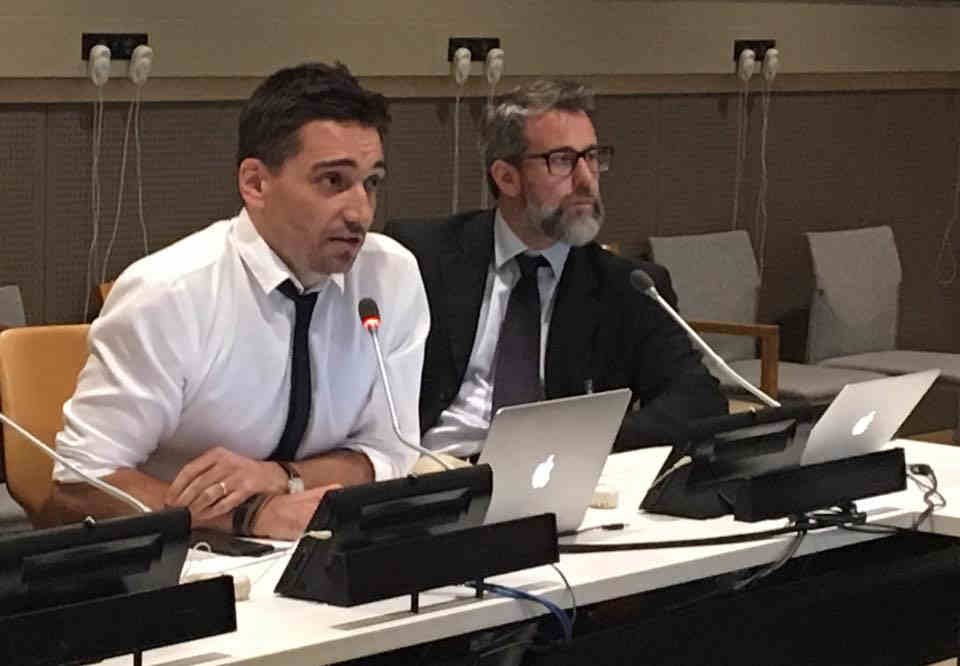
A jornalista e ativista dos direitos das pessoas com deficiência, Patricia Almeida, defendeu, em sua apresentação, que o Artigo 8 da Convenção sobre os Direitos das Pessoas com Deficiência, que trata de conscientização, deve ser também implementado pelos países como qualquer outro dos artigos. Segundo ela, a inclusão na mídia, feita de maneira apropriada, funciona como um “fast-track” para desfazer preconceitos, mudar atitudes e derrubar as barreiras que impedem a realização de todos os outros artigos da Convenção. O Instituto MetaSocial, representado no evento por Fernando Heiderich, realiza ações de advocacy para motivar essa inserção junto aos meios de comunicação de massa há mais de 20 anos, com resultados significativos. Patricia lembrou que a novela “Páginas da Vida”, de Manoel Carlos, exibida pela TV Globo em 2006, veio num momento crucial em que existia muita resistência à transição dos alunos com deficiência da escola especial para a regular. A menina Joana Mocarzel, que tem síndrome de Down, foi a primeira atriz com deficiência a ser protagonista em uma novela no Brasil. Joana contou com o apoio de Helena Werneck, do Instituto MetaSocial, nas gravações. Sua personagem, Clarinha, viveu situações da vida real, como a recusa de matrícula em escolas regulares e o público sofreu com a luta da mãe da menina em busca da inclusão. De acordo com Patricia, a história foi um divisor de águas. Antes da novela, as pessoas achavam que alunos com deficiência deveriam estudar em escola especial, depois, passaram a saber que as crianças com deficiência tinham direito a frequentar escolas regulares e que a aprendiam melhor em situações inclusivas. A jornalista citou organizações que promovem a inclusão das pessoas com deficiência na mídia, como a australiana Starting with Julius, focada em publicidade, e a GADIM – Global Alliance for Disability in Media and Entertainment. Disse que, com a demanda por novas produções por tvs a cabo, Netflix e Amazon, personagens com deficiência tem sido incluídos em séries americanas como Breaking Bad, Speechless, Switched at Birth e Born This Way. No Brasil, destacou a inclusão incidental como aconteceu recentemente em programas do GNT como “Fazendo a Festa” e “Cozinha Colorida de Kapim”, onde crianças com síndrome de Down tomaram parte sem “apontar o dedo” para isso. Por fim, elogiou a inciativa da Ofcom, agência que regula as comunicações no Reino Unido, que requer que as Tvs tenham uma política de equiparação de oportunidades com relação a grupos subrepresentados, sob pena de não terem suas licenças para transmissões renovadas. Ela afirmou que, por conta disso, o Reino Unido é um dos mais avançados em inclusão na mídia. Mais de 10% dos funcionários da BBC têm deficiência, o que, além de criar oportunidades de trabalho, provoca uma “inclusão por dentro” refletindo positivamente no conteúdo das TVs. Citou também lei do Distrito Federal que determina que pelo menos 5% dos modelos utilizados na publicidade pública sejam pessoas com deficiência. E deu o exemplo de uma publicidade inclusiva da Johnson’s & Johnson’s para o último dia das mães no Brasil, o famoso “Bebê Johnson’s”é representado por um bebê com síndrome de Down:
https://www.facebook.com/johnsonsbabybrasil/videos/1555782051099522/
Patricia terminou dando dicas para a promoção da inclusão na mídia localmente:
- Seja um embaixador da causa, interagindo com a mídia em sua localidade, usando esses materiais e outros recursos que você pode encontrar na web. Avise se precisar de ajuda. (info@gadim.org)
- Implemente alguma forma de reconhecimento deste processo, como um prêmio, por exemplo, para motivar pessoas e organizações a investir na diversidade e inclusão de talentos com deficiência como parte de sua estratégia corporativa.
- Use seu capital social para inspirar profissionais de mídia a incluírem pessoas com deficiência como parte de suas campanhas publicitárias, de forma natural, enfocando suas habilidades em vez de suas deficiências.
- Convoque pessoas interessadas no assunto de outros grupos subrepresentados para unir esforços em ações de advocacy para inclusão na mídia, a exemplo do Observatório da Diversidade na Mídia, criado recentemente no Brasil.
Fonte: Inclusive
ENGLISH TRANSLATION
Inclusion of people with disabilities through the media is the theme of an event at the UN
The Missions of Brazil and Italy to the United Nations promoted an event on the importance of insertion of people with disabilities in the media as a way to promote inclusion during the X Conference of States Parties to the Convention on the Rights of Persons with Disabilities (CRPD), at the UN headquarters in New York. The event was organized by the United Nations High Commissioner for Human Rights, the UN Special Rapporteur on the Rights of Persons with Disabilities, and GADIM – Global Alliance for Inclusion of Disability in Media and Entertainment.
Based on article 8 of the CRPD on awareness and on article 5 on equality and non-discrimination, the side event aimed to discuss strategies that can be led at local, national, regional and international levels to combat invisibility, promote positive perceptions and combat stigma and stereotypes against people with disabilities. Research shows that people with disabilities are present in less than 1% of entertainment productions, with 95% of disabled characters played by non-disabled actors.
In the event “How to promote inclusion through the media,” Fantastico’s reporter, Flavia Cintra, spoke about her behind-the-scenes performance, subsidizing the production of Manoel Carlos’s novel “Viver a Vida”, aired by TV Globo in 2009. She described the public reaction to the character Luciana, played by Alinne Moraes, a model who became quadriplegic at the beginning of the plot. According to Flavia, at first everyone was asking when the model would be cured. Later, acting like a spoiled girl, people were angry with the character. In the same way, they became indignant when the model faced barriers such as lack of accessibility. When they saw Luciana fall in love, the audience twisted by the soap opera and was curious to know if a tetraplegic would be able to have a sex life. In the end, after several months of daily “coexistence” through the soap opera, viewers only wanted Luciana to be happy. And the happy ending did not go through a cure, but through the marriage and birth of the twin sons. The journalist, also mother of twins, said that the telenovela allowed the public to “approach” the character and get to know her life closely. And that this coexistence has often contributed to reviewing preconceived ideas, naturalizing the look and changing attitudes towards people with disabilities in general. Later, Flavia was hired as a reporter by Fantastico, the biggest TV news program on TV, and said she went through a similar process. In the beginning, she was seen as the reporter in a wheelchair, and now she has become only Flavia, from Fantastico.
TV Globo’s Social Responsibility Manager, Raphael Vandystadt, spoke about the station’s performance in mobilizing around social issues and presented numbers. He quoted the program Criança Esperança (Child Hope) , carried out with UNESCO, which makes numerous projects possible, including in the area of disability. He said that last year’s human rights initiative “It starts with respect” has been launched with the support of UNICEF, UNAIDS and UN Women. The program comprises actions of journalism, TV programs, soap operas and employees training. Organizations of people with disabilities such as the MetaSocial Institute, Down Movement and Rodrigo Mendes Institute collaborated in several of the projects. In 2017 World Down Syndrome Day, more than 100 reports were made and a video was released that reached 2 million people and received 16 thousand shares in social networks. According to the representative of TV Globo, disabled characters have been part of TV Globo since 1975, and from 2007 until today have been counted more than 413 scenes involving these characters. According to him, the novels promote debate and reflection, provoking new behaviors on various subjects. Likewise, in 2016 alone, TV Globo showed more than 300 reports mentioning people with disabilities. In addition, since 2007, in partnership with 17 entities, the station produced and exhibited, without cost, 28 campaigns whose subjects were people with disabilities. These campaigns totaled 279 thousand insertions, an investment equivalent to US $ 48 million. Raphael closed the presentation with the video of the series Tudo semper pela Respeito, made in partnership with Instituto Rodrigo Mendes.
Italian publicist Luca Pannese of New York-based Publicis spoke about the campaigns for International Down’s Syndrome, developed with his creative partner Luca Lorenzini for the Italian association Coordown. The two have already won 20 Lions in the Cannes Film Festival in the last 5 years. Pannese argued that advertising campaigns should bring innovation and courage to have a really unimportant impact. In this case, he and his partner brought the innovation to the campaigns and the Coordown association came in with the courage. The film “Dear Mommy,” based on a letter where a woman pregnant with a baby with Down syndrome asks how her son’s life would be, has reached more than 8 million hits. The video was banned from being featured on French TV because it was considered “disruptive” to women who chose abortion. The #NotSpecial movie of 2017 uses humor to say that people with Down syndrome are nothing special, they just need human rights, like anyone else. The video also reached more than 8 million views.
The journalist and disability rights activist Patricia Almeida defended in her presentation that Article 8 of the Convention on the Rights of Persons with Disabilities, which deals with awareness, should also be implemented by countries like any other of the articles . According to her, appropriately mediated inclusion acts as a “fast track” to undo prejudices, change attitudes, and break down the barriers that prevent the achievement of all other articles of the Convention. The Instituto MetaSocial, represented at the event by Fernando Heiderich, carries out advocacy actions to motivate this insertion with the mass media for more than 20 years, with significant results. Patricia recalled that the novel “Páginas da Vida”, by Manoel Carlos, screened by TV Globo in 2006, came at a crucial moment in which there was a lot of resistance to the transition of students with disabilities from the special school to the regular school. The girl Joana Mocarzel, who has Down syndrome, was the first disabled actress to be the protagonist in a novel in Brazil. Joana had the support of Helena Werneck, from Instituto MetaSocial, on the recordings. Her character, Clarinha, lived in real life situations, such as refusal to enroll in regular schools and the public suffered from the struggle of the girl’s mother in search of inclusion. According to Patricia, the story was a watershed. Before the novel, people felt that students with disabilities should study in special schools, then learned that children with disabilities were entitled to attend regular schools and that they learned better in inclusive situations. The journalist cited organizations promoting the inclusion of people with disabilities in the media, such as the Australian Starting with Julius, focused on advertising, and GADIM – Global Alliance for Disability in Media and Entertainment. He said that with the demand for new productions by cable TV, Netflix and Amazon, disabled characters have been included in American series such as Breaking Bad, Speechless, Switched at Birth and Born This Way. In Brazil, he highlighted incidental inclusion as happened recently in GNT programs such as “Making the Party” and “Colored Kapim Cooking,” where children with Down syndrome took part without pointing a finger at it. Lastly, he praised the initiative of Ofcom, a UK-based communications agency, which requires TVs to have a policy of equalizing opportunities for underrepresented groups, otherwise they will not have their licenses for new broadcasts. She said that because of this, the UK is one of the most advanced in the media. More than 10% of BBC staff have disabilities, which, in addition to creating job opportunities, provokes an “inside insight” that positively reflects TV content. He also cited Federal District law that determines that at least 5% of the models used in public advertising are people with disabilities. She gave an example that showed how inclusion in advertising is improving in Brazil by showing a video for Mother’s Day by Johnsons’& Johnson’s, where the “Johnson’s Baby” is represented by a baby with Down Syndrome.
https://www.facebook.com/johnsonsbabybrasil/videos/1555782051099522/
Patricia ended up giving tips for promoting inclusion in the media locally:
Be a cause ambassador, interacting with the media in your locality, using these materials and other resources you can find on the web. Let me know if you need any help. (Info@gadim.org)
Implement some form of recognition of this process, such as a prize, for example, to motivate individuals and organizations to invest in the diversity and inclusion of disabled talent as part of their corporate strategy.
Use your social capital to inspire media professionals to include people with disabilities as part of their advertising campaigns, naturally, focusing on their abilities rather than their shortcomings.
Call on people interested in the subject of other underrepresented groups to join efforts in advocacy for inclusion in the media, such as the Media Diversity Observatory recently created in Brazil.
Luca Pannese has worked in Milan, London and New York, through McCann Erickson, Y&R, Saatchi & Saatchi and, in 2016, arrived in Publics New York as an Executive Creative Director. He has worked on Italian and international accounts like Lexus, Toyota, T-Mobile, Deutsche Telekom, Pampers and General Mills, bringing Italian warmth across the continent. In New York, he’s now running the Heineken account. With his lifetime partner Luca Lorenzini – together known as “Luca & Luca” – they have won 20 Lions in the last five years at the Cannes Lions Festival, in addition to several awards at the most prestigious advertising festivals in the world, such as The One Show, D&AD, New York Festival and many other regional awards, including two Grand Prix at the Italian Art Directors Club. Former Taekwondo national athlete, he now lives in Manhattan with his beautiful wife and their two kids who can still call him “Papà” and not “Dad.” They are the creators of video campaigns for World Down Syndrome Day, including award winning “Dear Future Mum”, and “#NotSpecial”, that reached together over 20 million views on social media.
Flavia Cintra is a journalist and human rights activist for people with disabilities. She has been a reporter for TV Globo’s Fantástico program since 2010. She has worked as a consultant for the soap opera “Viver a Vida”, in which the protagonist was based on her life story, aired in Brazil in 2009 and sold for dozens of countries. She is the author of the book “Maria de Rodas”, where she tells about her experience with motherhood of twins. Until 2006, she was vice-president of Instituto Paradigma, an organization that was part of the Ad Hoc committee created by the UN to elaborate the text of the Convention on the Rights of Persons with Disabilities. She is a frequent speaker at events dedicated to the theme of human rights and social inclusion.
Raphael Vandystadt is the Senior Manager of Social Responsibility for TV Globo since 2000. From 1996 to 2000, he was in charge of the Universal Channel Marketing division in Brazil. He has a MBA from the Business School of the Federal University of Rio de Janeiro (UFRJ), a Masters on Marketing from the Catholic University of Rio de Janeiro and a Masters on Strategies to Create Business and Social Value from Harvard Business School (HBS).
Patricia Almeida is a journalist, human rights activist and member of the board of trustees of Down Syndrome International. She coordinated civil society’s efforts that led to the adoption of World Down Syndrome Day by the United Nations in 2011. In Brazil, she is co-founder of Movimento Down, an information organization with over 260,000 followers on Facebook, founder of news agency on inclusion and human rights, Inclusive – Inclusion and Citizenship, and coordinator of MetaSocial Institute, that has been working with the media to promote the rights of persons with disabilities for over 20 years. In 2016, she created GADIM – Global Alliance for Disability in Media and Entertainment to foster international collaboration for inclusion in media. She is currently reading for a Masters in Disability Studies at City University of New York (CUNY).

